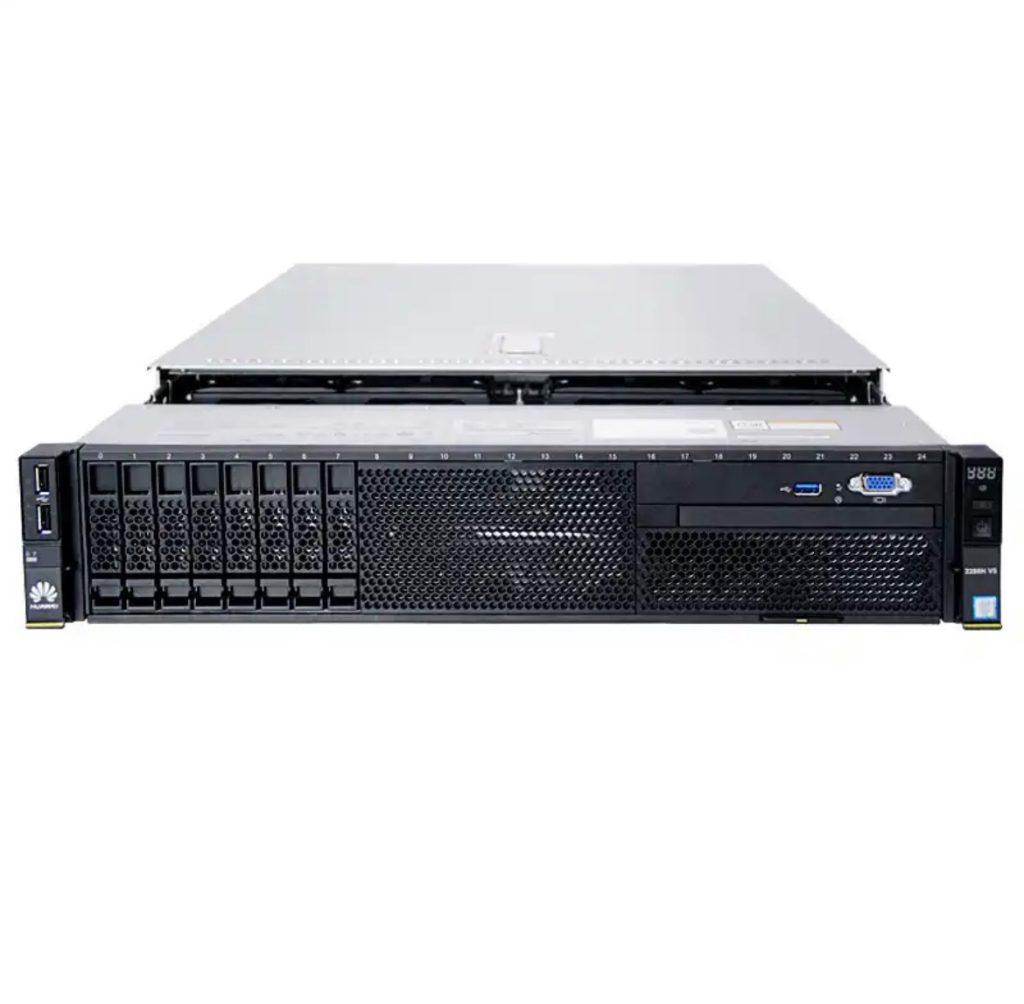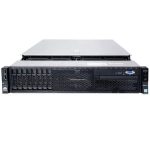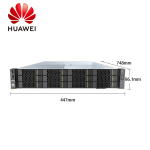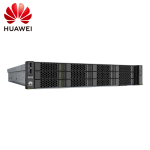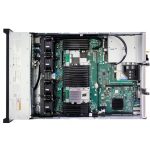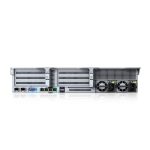|
Form factor
|
2U rack server
|
|
Chipset
|
Intel® C622
|
|
Processor
|
Supports one or two processors.
- Intel® Xeon® Scalable (Skylake and Cascade Lake) processors
- Built-in memory controller and six memory channels
- Built-in PCIe controller, supporting PCIe 3.0 and 48 lanes per processor
- Two UPI buses between processors, providing up to 10.4GT/s transmission per channel
- Up to 28 cores per processor
- Max. 3.8 GHz
- Min. 1.375 MB L3 cache per core
- Max. 205 W TDP
NOTE:
The preceding information is for reference only. Use the Compatibility Checker to obtain specific information.
|
|
DIMM
|
Supports 24 memory modules of the following types:
- Up to 24 DDR4 memory modules
- Max. 2933 MT/s memory speed
- RDIMM and LRDIMM support
- The DDR4 memory modules of different types (RDIMM and LRDIMM) and specifications (capacity, bit width, rank, and height) cannot be used together.
- Up to 12 DCPMMs
- The DCPMMs must be used with DDR4 memory modules together.
- The DCPMMs support the AD or MM mode.
- Max. 2666 MT/s memory speed
- The DCPMMs of different specifications cannot be used together.
- For details about the DCPMMs, see the FusionServer DCPMM User Guide.
NOTE:
The preceding information is for reference only. Use the Compatibility Checker to obtain specific information.
|
|
Storage
|
Supports a variety of drive configurations. For details, see Drive Configuration.
- Supports two M.2 SSDs.
- M.2 SSDs are supported only when the server is configured with an Avago SAS3004iMR RAID controller card.
- The drive letter of the M.2 SSDs managed by the Avago SAS3004iMR RAID controller card can be set to sda by modifying the GRUB parameters only when the RAID controller card is used with an SR130, SR760IT-M, SP150IT-M, or SmartRAID 3152-8i RAID controller card or a PCH.
NOTE:
- The M.2 SSD module is used only as the boot device when the OS is installed. Small-capacity (32 GB or 64 GB) M.2 SSDs do not support logging due to poor endurance. If a small-capacity M.2 SSD is used as the boot device, a dedicated log drive or log server is required for logging. For example, you can dump VMware logs in either of the following ways:
- Redirect /scratch. For details, see https://kb.vmware.com/s/article/1033696.
- Configure syslog. For details, see https://kb.vmware.com/s/article/2003322.
- The M.2 SSD is not recommended for write-intensive service software due to poor endurance.
- Do not use the M.2 SSD as the cache.
NOTE:
If the BIOS is in legacy mode, the 4K drive cannot be used as the boot drive.
|
|
Network
|
Supports expansion capability of multiple types of networks.
- LOM
- Supports two 10GE optical ports and two GE electrical ports via the NIC chip integrated on the mainboard.
- Supports two 10GE electrical ports and two GE electrical ports via the NIC chip integrated on the mainboard.
- The LOM ports support NC-SI, WOL, and PXE.
- FlexIO card
- Supports on-demand configuration.
- Supports a variety of FlexIO cards. Use the Compatibility Checker to obtain information about the specific FlexIO cards supported.
- When IB cards are used to build an IB network, ensure that the IPoIB modes of the IB cards at both ends of the network are the same. For details, contact technical support.
NOTE:
- The electrical ports provided by LOMs, FlexIO cards, and PCIe NICs cannot be connected to PoE devices (such as a switch with PoE enabled). Connecting such an electrical port to a PoE device may cause link communication failure or even damage the NIC.
- Forcibly powering off a server will cause intermittent NC-SI disconnection and disable the WOL function of the LOM ports. To restore the NC-SI connection, refresh the iBMC WebUI.
|
|
I/O expansion
|
10 PCIe 3.0 slots:
- Support PCIe SSD cards to bolster I/O performance for applications such as searching, caching, and download services.
- Supports GPU cards.
- When IB cards are used to build an IB network, ensure that the IPoIB modes of the IB cards at both ends of the network are the same. For details, contact technical support.
NOTE:
The preceding information is for reference only. Use the Compatibility Checker to obtain specific information.
|
|
Port
|
Supports a variety of ports.
- Ports on the front panel:
- Two USB 2.0 ports
- One USB 3.0 port
- One DB15 VGA port
NOTE:
For the server that uses 12 x 3.5″, 20 x 2.5″ (8 x SAS/SATA + 12 x NVMe) or 25 x 2.5″ drive configuration, the front panel provides only two USB 2.0 ports.
- Ports on the rear panel:
- Two USB 3.0 ports
- One DB15 VGA port
- One RJ45 serial port
- One RJ45 system management port
- Two GE electrical ports
- Two 10GE electrical ports or 10GE optical ports
- Built-in ports:
- One USB 3.0 port
- Two SATA ports
NOTE:
In the 8 x 2.5″ or 24 x 2.5″ drive configuration, only two SATA built-in ports are provided.
NOTE:
You are not advised to install the operating system on the USB storage media.
|
|
Video card
|
An SM750 video chip with 32 MB display memory is integrated on the mainboard. The maximum display resolution is 1920 x 1200 at 60 Hz with 16 M colors.
NOTE:
- SM750 is not supported by servers running the Windows Server 2019 or Windows Server 2019 Hyper-V operating systems that are in secure boot mode.
- The integrated video card can provide the maximum display resolution (1920 x 1200) only after the video card driver matching the operating system version is installed. Otherwise, only the default resolution supported by the operating system is provided.
- If the chassis provides the front and rear VGA ports but only one VGA port is connected to a monitor, the display effect may be affected.
|
|
System management
|
- Supports UEFI.
- Supports iBMC.
- Supports NC-SI.
- Supports integration with third-party management systems.
|
|
Security feature
|
- Power-on password
- Administrator password
- TCM (only in China)/TPM
- Secure boot
- Front bezel (optional)
|
